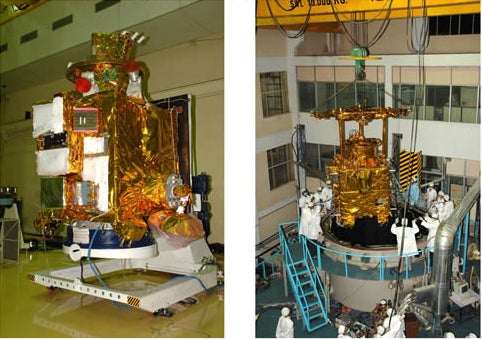A sophisticated X-ray camera made by scientists and engineers from the United Kingdom’s Science and Technology Facilities Council (STFC) is set to launch into space October 22 aboard the Chandrayaan-1 spacecraft — India’s first mission to the Moon.
This is the first time the UK and India have collaborated in space science.
The camera — C1XS — was designed and built at STFC Space Science and Technology Department at RAL. It is an X-Ray Spectrometer that will measure X rays to map the Moon’s surface composition. This will help scientists understand the Moon’s origin and evolution, as well as quantifying the mineral resources that exist there. An animation visualizing the C1XS instrument conducting lunar science and the Chandrayaan-1 spacecraft in transit from the Earth to the Moon is available online.
“Launches are always an incredibly nail-biting and exciting time in a mission,” says Chris Howe, C1XS Chief Engineer, from STFC Space Science and Technology Department. “After all our hard work, we’re all eager to see C1XS safely on its way so that it can get to work uncovering more of the Moon’s secrets.”
Chandrayaan-1 is the first lunar mission from the Indian Space Research Organisation (ISRO). It is designed to orbit the Moon and carry radar and particle detectors as well as instruments that will make observations in the visible, near infrared, and X-ray part of the electromagnetic spectrum.
“There is still a lot we don’t know about the Moon,” says Ian Crawford from Birkbeck College, who chairs the C1XS Science Team. “Accurate maps of the surface composition will help us unravel its internal structure and geological history. Among other things, this will help us better understand the origin of the Earth-Moon system. We will also be able to learn more about what happened on the Moon since it formed and how and when it cooled. By peering into its craters, we may even be able to see below its crust to the material underneath.”
C1XS was developed in conjunction with the Indian Space Research Organisation. It employs new technology to make a compact, lightweight, sensitive instrument that can measure the abundance of chemical elements in the lunar surface, by detecting the X rays they absorb and re-emit. The spectrometer builds on a successful technology demonstration called D-CIXS, which was launched aboard the European Space Agency’s (ESA) Smart-1 mission to the Moon.
C1XS will work by looking at X rays from the Sun that atoms in the lunar soil have absorbed, then re-emitted in such a way as to reveal the surface’s chemical makeup. The spectrometer is sensitive to magnesium, aluminium, and silicon X rays. When the solar X-ray illumination is bright, for example during a solar flare, it may also be able to make measurements of other elements such as iron, titanium, and calcium. To measure the surface elements accurately it is essential to measure the X rays the Sun produces. C1XS has an additional detector system to measure these X rays called the X-ray Solar Monitor (XSM), provided by the University of Helsinki Observatory, Finland.
“C1XS uses an advanced version of conventional CCD sensors such as you might find in a digital camera, called swept charge devices,” says Chris Howe, C1XS Chief Engineer, from STFC Space Science and Technology Department. “These are mounted behind a gold/copper ‘collimator’, which limits the field of view of the X-ray detectors to a narrow beam. Together these two innovations form an X-ray camera that has high resolution allowing identification of the surface elements, yet is far more compact and lower mass than other spacecraft’s X-ray spectrometers.”










